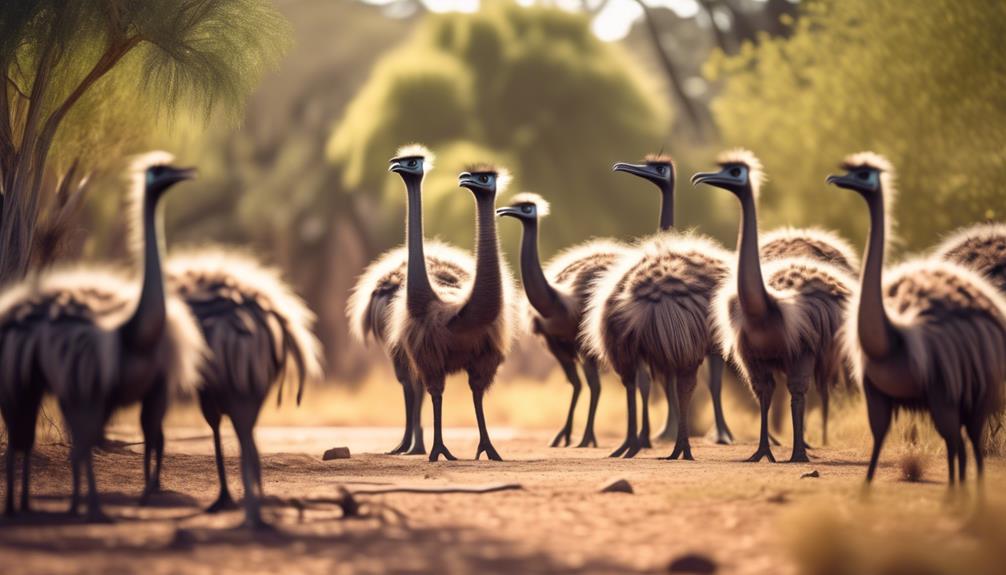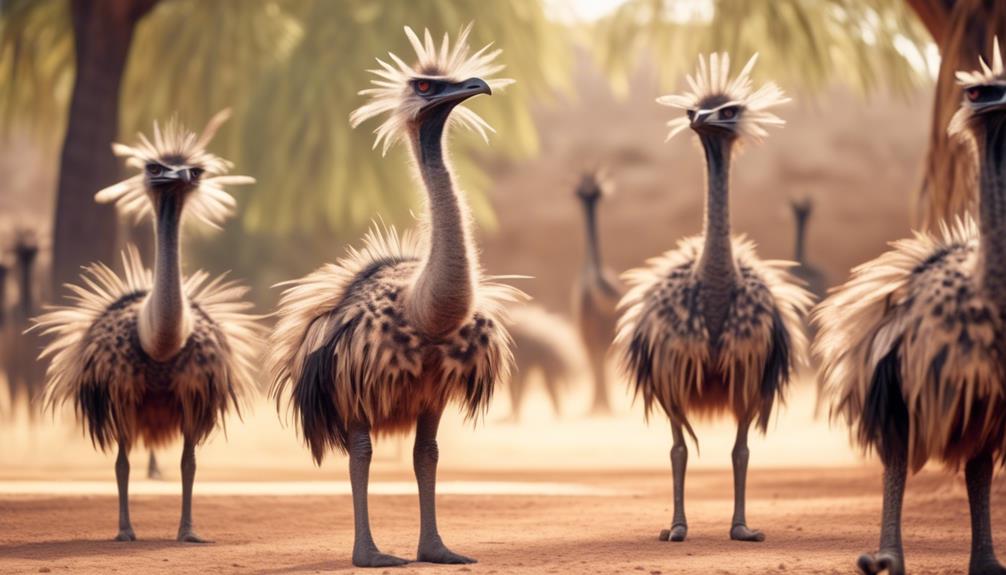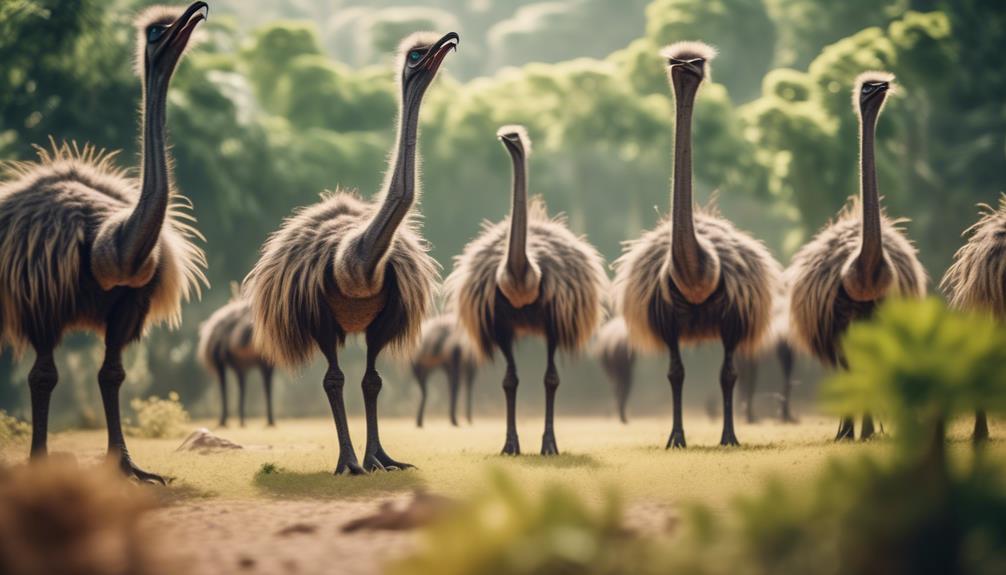
You might be thinking, 'Why should I care about prehistoric emus?' Well, let me tell you, these ancient creatures hold the key to understanding the origins of the birds we see today.
By studying their evolution and behavior, we can gain fascinating insights into the ways in which birds have adapted and survived throughout time. From their unique feeding habits to their complex social behaviors, prehistoric emus offer a captivating glimpse into the distant past.
But that's not all – their interactions with other prehistoric species and their lasting influence on modern birds will leave you wanting to uncover more.
So, prepare to embark on a journey through time as we explore the ancestors of today's birds and unravel the mysteries of prehistoric emus.
The Evolutionary Timeline of Emus

The evolutionary timeline of emus begins millions of years ago, with the emergence of their prehistoric ancestors. These early emus, known as Dromornithids, were massive flightless birds that roamed the ancient landscapes of Australia. Over time, the emu lineage underwent remarkable evolutionary adaptations, allowing them to thrive in diverse environments.
One of the key evolutionary adaptations of emus is their long and powerful legs. These limbs enable emus to run at high speeds, reaching up to 31 miles per hour. Such agility is crucial for their survival, as it allows them to escape from predators and cover large distances in search of food and water.
Another significant adaptation is their reduced wing size. Emus possess small, vestigial wings that are useless for flight. However, these wings serve a different purpose in their ecological significance. They help emus maintain balance while running and assist in courtship displays, where males use their wings to attract mates.
Emus also have a specialized digestive system that allows them to consume a wide variety of plant matter. Their stomachs have adapted to break down tough vegetation, making them well-suited to survive in arid and semi-arid regions.
The evolutionary adaptations of emus highlight their remarkable ability to adapt and thrive in different environments. These adaptations have played a crucial role in their ecological significance, shaping their behavior, physical attributes, and overall success as a species.
Fossil Discoveries and Paleontological Insights
Through the analysis of fossils and the insights gained from paleontological research, significant discoveries have shed light on the evolutionary history of emus and provided valuable information about their ancient ancestors. Fossil preservation plays a crucial role in uncovering the secrets of the past. Fossils are formed when the remains of organisms are buried and undergo a process called mineralization, where minerals replace the organic matter, preserving the structure and morphology of the organism. This allows paleontologists to study the anatomy and characteristics of ancient emus.
Scientific techniques are employed to extract as much information as possible from fossils. For instance, computed tomography (CT) scans can provide detailed images of the internal structures of fossils, revealing intricate details that would otherwise be hidden. Isotopic analysis, which examines the ratio of stable isotopes in fossilized remains, helps scientists understand ancient ecosystems, diets, and migration patterns.
Ancient Emu Species: Unraveling the Past

Ancient emu species can be unraveled through the meticulous study of fossils and the application of scientific techniques, providing valuable insights into the evolutionary history of these remarkable birds. By examining the remains of ancient emus, researchers can uncover important information about their evolutionary adaptations and the ecological niches they occupied.
One such ancient emu species is Dromaius stirtoni, which lived during the Late Pleistocene in Australia. This species was significantly larger than its modern counterparts, with a height of approximately 2 meters and a weight of over 200 kilograms. Its robust skeletal structure suggests adaptations for a more terrestrial lifestyle, possibly indicating a shift in ecological niche.
Another ancient emu species, Dromaius baudinianus, existed during the Early Pleistocene. Fossil evidence suggests that this species had a more slender build compared to modern emus, indicating a different set of evolutionary adaptations. It's hypothesized that D. baudinianus may have been better suited for running and agility, possibly occupying a different ecological niche than its larger counterparts.
Through the careful analysis of fossil remains and the application of scientific techniques, researchers can continue to unravel the mysteries of ancient emu species. These findings provide invaluable insights into the evolutionary history of these birds and how they've adapted to different ecological niches over time.
Adapting to Prehistoric Environments
Emus in prehistoric environments exhibited remarkable adaptations to survive and thrive. These adaptations were necessary for their survival in the harsh conditions of the prehistoric climate and allowed them to occupy various ecological niches. Here are some of the key adaptations that emus developed:
- Physical Adaptations
- Emus evolved to have long, strong legs, which enabled them to cover large distances and escape from predators quickly.
- They developed long, powerful necks that allowed them to reach vegetation at different heights, ensuring a steady food supply.
- Emus possessed strong, sharp beaks that were ideal for foraging and consuming a diverse range of plant matter.
- Their feathers were designed to provide insulation in both warm and cold climates, helping them regulate their body temperature.
- Behavioral Adaptations
- Emus developed the ability to store fat reserves in their bodies, allowing them to survive during times of food scarcity.
- They exhibited a high level of adaptability, being able to adjust their feeding habits based on the availability of resources in their surroundings.
- In response to the changing prehistoric climate, emus became nomadic, migrating to areas with more favorable conditions.
These adaptations allowed emus to successfully navigate the challenges posed by the prehistoric environment and occupy a variety of ecological niches. Their ability to adapt and thrive in different conditions is a testament to their resilience and evolutionary prowess.
Feeding Habits and Dietary Evolution

Emus' feeding habits and dietary evolution offer insights into their ecological role and evolutionary history. These large flightless birds have developed unique foraging strategies and dietary adaptations over millions of years, enabling them to thrive in diverse environments. By examining their feeding behaviors and dietary preferences, we can uncover valuable information about their ancestors and their place in the natural world.
Emus are opportunistic feeders, meaning they adapt their foraging strategies based on the availability of food. Their diet primarily consists of plant matter, including fruits, seeds, flowers, and leaves. However, they are also known to consume insects, small vertebrates, and even carrion when necessary. This flexibility in diet allows emus to survive in a variety of habitats, from grasslands to forests.
To further illustrate the dietary evolution of emus, the following table outlines their foraging strategies and dietary adaptations:
| Foraging Strategy | Dietary Adaptation | Example |
|---|---|---|
| Grazing | Long neck and legs | Emus can easily reach grasses and low-lying vegetation for grazing |
| Browsing | Flexible beak and neck | Emus can pluck leaves and fruits from trees, adapting to arboreal food |
| Scavenging | Strong digestive system | Emus can consume carrion and digest tough animal tissues |
Emus' feeding habits and dietary evolution reveal their remarkable adaptability, allowing them to survive and thrive in various ecological niches. Understanding these adaptations not only sheds light on their evolutionary history but also provides valuable insights into the broader field of avian ecology and the intricate relationship between animals and their environments.
Physical Characteristics of Prehistoric Emus
By examining the feeding habits and dietary evolution of Emus, we can now shift our focus to exploring the physical characteristics of these prehistoric birds. Emus, like their modern descendants, possessed a number of adaptive traits that allowed them to thrive in their environment. These evolutionary adaptations can be seen in their physical features, which were specifically designed to enhance their survival and reproductive success.
The physical characteristics of prehistoric Emus can be summarized as follows:
- Body Size and Shape:
- Emus were large birds, standing at an average height of approximately 6.6 feet (2 meters) tall.
- They had a slender body shape, with long legs and a long neck that facilitated efficient movement and foraging.
- Feathers and Plumage:
- Emus had a dense covering of feathers that provided insulation and protection from the elements.
- Their plumage was predominantly brown in color, allowing them to blend in with their surroundings and avoid detection from predators.
- Beak and Head:
- Emus had a robust, downward-curved beak that was well-suited for foraging on a variety of plant material.
- Their head was small in proportion to their body, with a relatively large eye that provided them with good vision.
These physical characteristics demonstrate the remarkable evolutionary adaptations that prehistoric Emus developed to survive and thrive in their ancient habitats.
Reproduction and Social Behaviors in Ancient Emus

The reproductive and social behaviors of ancient Emus provide key insights into their evolutionary strategies and interactions within their ecological communities. Emu courtship rituals were an integral part of their reproductive cycle. Males would gather in groups and compete for the attention of females through elaborate displays. These displays involved puffing up their feathers, vocalizing loudly, and performing rhythmic dances. The aim was to impress the females and establish dominance amongst their competitors.
Once a pair formed, the male and female would engage in a series of courtship behaviors, such as mutual preening and vocal exchanges. These rituals helped to strengthen the bond between the mates and establish a solid foundation for successful reproduction.
Parental care in ancient emus was also a crucial aspect of their social behavior. After mating, the female would lay a clutch of large, greenish eggs in a shallow nest. The male would then take over the responsibility of incubating the eggs, while the female would leave to find another mate and lay a second clutch. The male would diligently protect the eggs from predators and maintain the appropriate temperature until they hatched.
Once the chicks emerged, both parents would actively participate in their upbringing, providing them with food and protection. This cooperative parenting strategy likely contributed to the survival and success of the ancient Emus in their ecological communities.
Migration Patterns and Range Expansion
Migration patterns and range expansion in ancient emus were influenced by various environmental factors and evolutionary pressures. These factors shaped the movement of emus and their ability to adapt to changing landscapes. Here are some key points to consider:
- Migration routes: Ancient emus exhibited specific migration routes that took them across vast distances. These routes were influenced by factors such as the availability of food and water, as well as the need to avoid predators. Understanding these routes can provide insights into the ancient emus' behavior and habitat preferences.
- Climate change impacts: Climate change played a significant role in shaping the migration patterns and range expansion of ancient emus. As the climate changed over time, emus had to adapt to new environments and find suitable habitats. This led to their movement across different regions and their ability to colonize new areas.
- Expanding ranges: Ancient emus were capable of expanding their ranges in response to changing environmental conditions. This allowed them to occupy new territories and explore different habitats. The expansion of their ranges was driven by a combination of ecological opportunities, such as the availability of resources, and evolutionary pressures, such as competition with other species.
Understanding the migration patterns and range expansion of ancient emus provides valuable insights into their behavior and evolutionary history. By studying these aspects, scientists can gain a better understanding of how birds, including modern emus, have adapted and dispersed over time.
Interactions With Other Prehistoric Species

During their existence, ancient emus interacted with a diverse range of prehistoric species, shaping their ecological relationships and influencing their evolutionary trajectory. These interactions with other prehistoric species played a crucial role in determining the ecological niches occupied by the emus and the strategies they employed for survival.
One of the key interactions involved competition for resources with other herbivorous dinosaurs. As large terrestrial herbivores, ancient emus likely shared similar food sources with other plant-eating dinosaurs. This led to intense competition for limited vegetation, forcing emus to adapt and specialize in feeding on specific types of plants. Through this competition, emus honed their foraging skills and developed unique feeding strategies that allowed them to successfully exploit their ecological niche.
Furthermore, the presence of predators such as carnivorous dinosaurs and large reptiles also influenced the behavior and survival strategies of ancient emus. To avoid predation, emus may have evolved to be more alert and agile, enabling them to detect and evade potential threats. They may have also developed social behaviors to enhance their collective defense against predators.
These interactions with other prehistoric species not only shaped the ecological roles of ancient emus but also had a lasting impact on their evolutionary trajectory. By adapting to their changing environment and developing specialized ecological niches, ancient emus were able to thrive alongside other prehistoric species and ultimately pave the way for the evolution of modern birds.
The Legacy of Prehistoric Emus in Modern Birds
As a result of their interactions with other prehistoric species, the legacy of ancient emus can be observed in the characteristics and behaviors of modern birds. These ancient emus played a crucial role in shaping the breeding patterns and communication methods that we see in birds today.
Breeding Patterns:
- Sexual Selection: The prehistoric emus engaged in elaborate courtship displays, where males showcased their physical prowess and vibrant plumage to attract females. This sexual selection process still exists today, as seen in the elaborate dances and displays of many bird species during the breeding season.
- Nest Building: Ancient emus were known for their intricate nest construction, with both males and females contributing to the building process. This behavior has been inherited by many modern bird species, where both parents take part in constructing the nest and caring for the eggs.
Communication Methods:
- Vocalizations: Prehistoric emus had a wide range of vocalizations to communicate with each other. These vocalizations were used for various purposes, such as establishing territory, attracting mates, and warning of potential threats. Today, birds continue to use vocalizations as a vital means of communication.
- Visual Displays: Ancient emus employed visual displays, such as fluffing their feathers and performing intricate dances, to communicate dominance and attract mates. Many modern bird species have also adopted similar visual displays as a way to establish social hierarchy and attract potential partners.
The legacy of prehistoric emus is evident in the breeding patterns and communication methods of modern birds. Through the inheritance of these traits, birds have evolved into the diverse and fascinating creatures we see today.
Frequently Asked Questions
How Many Different Species of Ancient Emus Have Been Discovered?
You'll be fascinated to learn that the fossil record has revealed the existence of several different species of ancient emus. The study of Emu evolution has provided valuable insights into the ancestors of today's birds.
What Were the Main Factors That Led to the Extinction of Ancient Emus?
The main factors that led to the extinction of ancient emus were changes in climate and habitat loss. The impact of climate change on ancient emus was significant, as it altered their environment and affected their ability to survive.
Did Ancient Emus Have Any Predators?
Ancient emus did have predators, although not many were able to successfully hunt them due to their large size and powerful legs. Their diet and hunting techniques likely played a role in their ability to evade predation.
How Did the Physical Characteristics of Ancient Emus Differ From Modern Emus?
The physical characteristics of ancient emus differed from modern emus due to evolutionary adaptations. Fossil discoveries have revealed changes in size, beak shape, and limb structure, reflecting their ancestors' environment and lifestyle.
Were Ancient Emus Capable of Flight?
Ancient emus, the flightless bird ancestors, were not capable of flight. Through emu evolution, they developed adaptations such as reduced wing size and stronger legs, enabling them to thrive on the ground.
Conclusion
In conclusion, delving into the world of prehistoric emus has provided invaluable insights into the origins and evolutionary history of modern birds.
Through the examination of fossils and paleontological evidence, we've unraveled the past of these ancient emu species, shedding light on their adaptations to prehistoric environments, dietary evolution, reproductive and social behaviors, migration patterns, and interactions with other species.
The legacy of prehistoric emus lives on in the diverse and vibrant bird species we see today, a testament to their remarkable resilience and adaptability.




